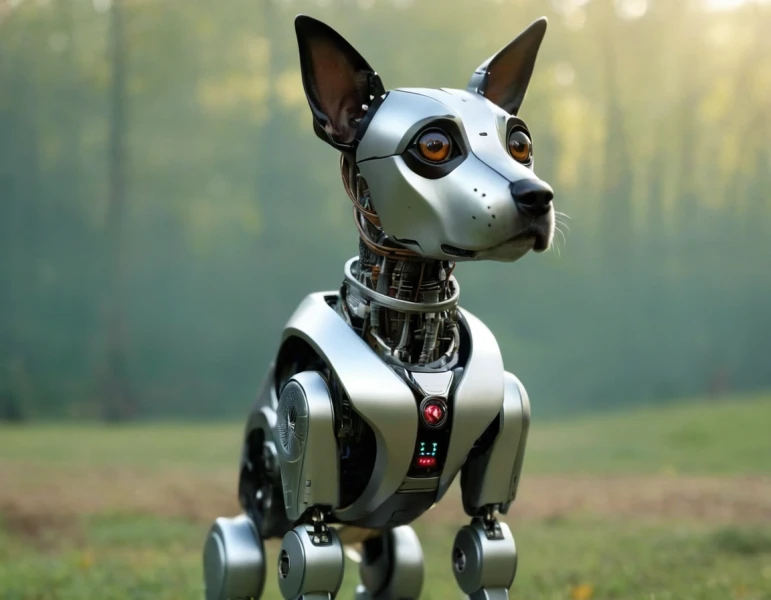Educa UNIVERSITY|SCIENCE AND ENGINEERING
Robot Dog: Discover All About the Future of Quadruped Robotics
Related Masters
Robot Dog: Discover All About the Future of Quadruped Robotics
Hello, I'm Carlos Hidalgo, and I want to talk to you about something that has always fascinated me: robot dogs. Yes, those metallic "puppies" that look like something out of a science fiction movie, but that today are redefining concepts such as surveillance, human-machine interaction and even entertainment.
Throughout my career, I've been lucky enough to work with some of the most advanced models. From experimental prototypes to machines that now patrol our streets or inspect factories, each robot dog has made it clear to me that the future is not tomorrow, but today.
What is a robot dog?

Basically, a robot dog is a quadruped device designed to replicate the movement and, in some cases, the behavior of a real dog. They are equipped with sensors, cameras and artificial intelligence technology to interact with their environment autonomously or semi-autonomously.
The most advanced models, such as Boston Dynamics' Spot or Xiaomi's CyberDog 2, are capable of performing complex tasks such as climbing stairs, avoiding obstacles, and yes, even doing backflips! (Imagine that in a German shepherd.)
My first time with a robot dog: between amazement and learning
Years ago, when I was working in a robotics lab, we had access to a Boston Dynamics prototype. I am not exaggerating when I say that I felt like I was in an episode of Black Mirror. Watching it move with an almost natural fluidity was.... both unsettling and fascinating.
The intelligence of these robots is overwhelming. They can map their environment with LiDAR cameras, detect humans with depth sensors and, most impressively, adapt to changing situations thanks to their advanced AI.
Robot dogs and their applications
Security and surveillance:
In Singapore, robot dogs have been used to patrol parks during the COVID-19 pandemic. In the United States and Europe, companies such as Hyundai and Boston Dynamics have developed models to guard factories and conduct inspections in hard-to-reach areas.
Rescue operations:
Thanks to their ability to navigate complicated terrain, robot dogs such as Spot or ANYmal from ANYbotics are ideal for rescue missions in natural disasters.
Entertainment and education:
Models such as the CyberDog 2 are more accessible to the general public. Can you imagine having a robot that can follow you around, respond to your gestures and even recognize your face? Perfect for tech enthusiasts and developers.
Defense and control:
Although controversial, some robot dogs have already been equipped with weaponry for military and crowd control applications.
Model market highlights
Boston Dynamics Spot:
A versatile robot that stands out for its mobility on uneven terrain. Equipped with advanced sensors, it can perform industrial inspections and rescue operations with surgical precision.
CyberDog 2 by Xiaomi:
More affordable and aimed at the general public, this model stands out for its open source ecosystem. It is the dream toy for programmers and the technologically curious.
ANYmal from ANYbotics:
Designed for industrial applications, this Swiss robot dog combines robustness and autonomy for extreme environments.
Vision 60 from Ghost Robotics:
Focused on military and rescue applications, this model has attracted attention for its ability to be equipped with specialized tools.
Robot dog: toy, tool or threat?
I know what you're thinking: "Are these robots a good idea or just another step toward a machine-dominated future?" The truth is, it depends on how we use them.
Advantages:
- Autonomy: They can perform repetitive or dangerous tasks without human intervention.
- Efficiency: Their sensors and processors make them ideal for collecting and analyzing data in real time.
- Adaptability: From factories to disaster zones, they adapt to multiple contexts.
Disadvantages:
- Cost: Some models like Spot run around $75,000.
- Ethics: Military use and constant monitoring raise serious concerns.
- Dependence: Relying too much on these machines could lead to human obsolescence in certain tasks.
My conclusion: Should you get a robot dog?
If you're a tech geek like me, go for it! They're a fascinating investment and, with models like the CyberDog 2, increasingly affordable. But if you're looking for something to replace the unconditional love of a real dog? maybe you should visit a kennel before you click "buy."
In any case, robot dogs are here to stay, and while they don't bark or wag their tails, they do show us that the future is as exciting as it is unpredictable.
Faculties
Trainings
The faculties embrace diverse academic disciplines and fields of study, opening doors to new perspectives and exploring different spheres of wisdom in a constantly evolving world.














